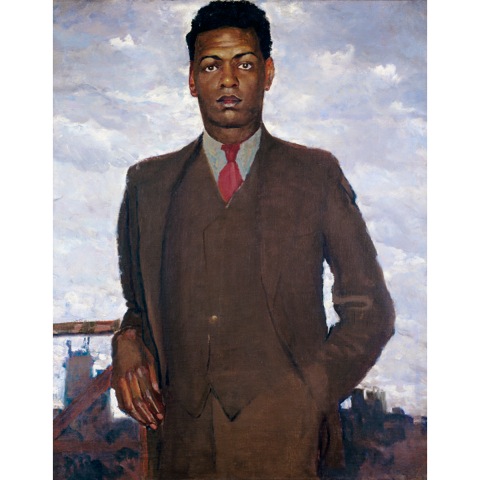“In the Shadow of Stalin: The Patterson Family in Painting and Film,” an exhibit at The Fralin Museum of Art at the University of Virginia running through Dec. 22, examines a 1932 journey by Langston Hughes and several of his African-American peers to the Soviet Union.
They were hoping to work on a film in Russia entitled “Black and White,” about racism in the United States. Even though Russia was a key player in the global film industry at that time, the film was never made -- yet the remarkable journey profoundly affected many who took the trip.
The traveling party included Lloyd Walton Patterson, a theater designer and Hampton University student, one of several visitors who opted to remain in the Soviet Union.
Patterson ended up marrying Vera Aralova, an artist with whom he had three children, including James Lloydovich Patterson, who was celebrated for his role in director Grigorii Aleksandrov’s popular 1936 Russian film, “Circus” – and who later achieved recognition for his poetry.
Hughes documented his travels in the Soviet Union in “I Wonder as I Wander: An Autobiographical Journey,” in a nonfiction prose memoir published in 1956.
Items displayed in The Fralin Museum of Art’s exhibition include a photograph of members of the Friends of the Soviet Union’s Harlem chapter en route to Russia, reproductions of promotional posters for “Circus” (and a flat screen monitor playing a scene from the film), various archival materials and a painting of Lloyd Patterson.
The Patterson portrait was painted by an unknown artist, and was discovered rolled up in the back of a Moscow antique shop in 1992 – which prompted the buyer’s curiosity about the African-American expatriate’s intriguing family story.
In conjunction with the exhibition, a symposium, “In the Shadow of Stalin: African-American Artists and Intellectuals in Soviet Russia,” organized by the museum and U.Va.’s Department of Slavic Languages and Literatures, will be held Saturday from 10 a.m. to 5 p.m. in Campbell Hall, room 153. It will draw scholars from a wide range of disciplines to examine the diverse experiences of African-Americans who visited and worked in the Soviet Union during the Stalin era.
“Cross-cultural exchanges in the 20th century have been explored before, but mainly with a focus on the experiences of African-Americans and their contemporaries in Western Europe,” said Jennifer Farrell, one of the symposium organizers and curator of exhibitions and contemporary art at the museum. “Links between African-American intellectuals and artists and the Soviet Union, while important, are not widely known.”
The symposium aims to expand the discussion to include the Soviet Union and, in the process, add to understandings of both American and Soviet history, as well as race, culture, political activism and artistic creation in the mid-20th century.
An informal coffee reception at 9 a.m. will precede the symposium. When the symposium breaks for lunch, participants are invited to view the exhibition, where a docent will be on hand to answer questions.
A full list of the speakers and moderators at the symposium and the day’s schedule can be found here.
The symposium is free, but registration is required. Contact Katelyn Hobbs at 434-924-6322 or kkh4q@virginia.edu.
The symposium organizers include Farrell; Edith Clowes, Brown-Forman Professor of Slavic Languages and Literatures; and M. Jordan Love, the museum’s academic curator.
The Fralin Museum of Art’s programming is made possible by the support of The Joseph and Robert Cornell Memorial Foundation.
The symposium is additionally sponsored by U.Va.’s Center for International Studies; Center for Russian, East European and Eurasian Studies; College of Arts & Sciences; Institute of the Humanities and Global Cultures; Department of English; McIntire Department of Art; Corcoran Department of History; and the Carter G. Woodson Institute for African-American and African Studies.
Media Contact
Article Information
October 21, 2013
/content/uva-symposium-and-exhibit-explores-experiences-african-americans-soviet-union

